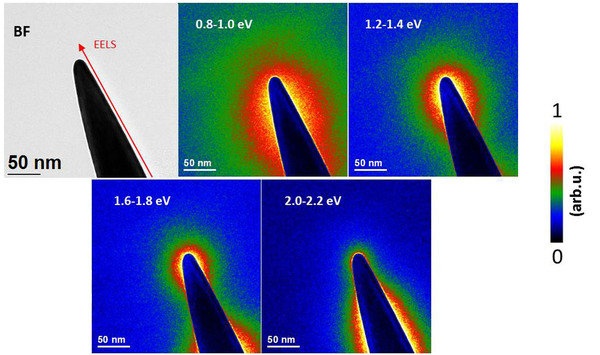
Investigation of plasmonic modes of gold tapers by EFTEM and EELS
Surface plasmons are collective oscillations of conduction electrons at the surfaces of metals. The coupling of plasmons and light and the propagation of surface plasmons at surfaces have been intensively studied. A very interesting application of surface plasmons is the localization of optical energies in metallic nanostructures at the nanometer scale using so-called nanoantennas.
Electron energy-loss spectroscopy (EELS) has been among the first methods for investigating surface plasmons through their coupling with relativistic electron beams. Only recently, by enormously improving the EELS technology, with the introduction of aberration-corrected magnetic lenses and monochromated electron guns, has it become possible to investigate the optical modes at the single nanoparticle level with a huge band-width [1]. Moreover, theoretical advances have also shown that the EELS signal can be interpreted as the local density of optical modes projected along the electron trajectory [1].
In this project, we apply energy-filtered transmission electron microscopy (EFTEM) and EELS in an investigation of localized surface plasmon (LSP) modes at apices of gold tapers with different apex shapes and opening angles. Because of the high performance of the employed Zeiss SESAM electron microscope [2], more fine details at taper apices are rendered with both high energy and high spatial resolution.
EFTEM can be exploited to map the real-space distribution of a selected energy range in a reasonably short time. We have found that a smoothly tapered gold apex supports a broadband LSP resonance with a bandwidth up to 2.0 eV. More details of the broadband local density of optical states at each taper apex are indicated by individual EELS line scans. A very exciting feature obvious in these experiments is the higher order resonances forming an interference-like pattern, with a hyperbolic-like dispersion becoming apparent in the energy-distance map. To understand the physics behind such resonances, we calculate the theoretical EELS spectra using the three-dimensional finite-difference time-domain technique with an embedded electron source [3]. Our calculations demonstrate that the higher-order resonances are due to the excitation of whispering gallery modes of the structure. We further support our observations with theoretical calculations of the EELS spectra from rods and spheres, which also sustain similar whispering gallery modes.
[1] F.J. García de Abajo, Rev. Mod. Phys. 82 (2011) 209-275
[2] C.T. Koch, W. Sigle, R. Höschen, M. Rühle, E. Essers, G. Benner, M. Matijevic, Microscopy and Microanalysis 12 (2006) 506-514
[3] N. Talebi, New J. Phys. 16 (2014) 053021
The research leading to these results has received funding from the European Union Seventh Framework Programme [FP7/2007-2013] under grant agreement no. 312483 (ESTEEM2).